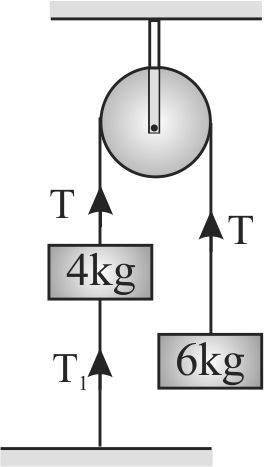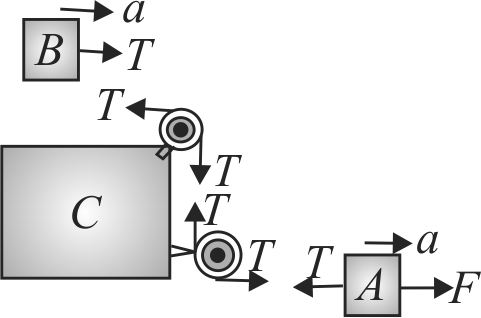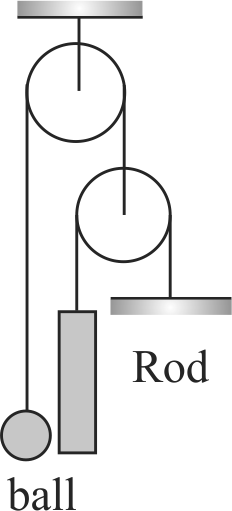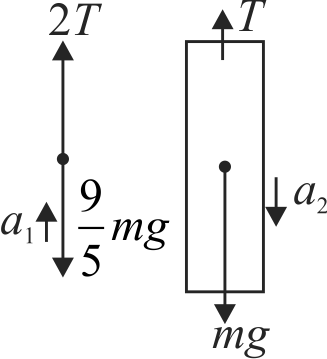363071
Three blocks \(A, B\) and \(C\) of masses \(10 {~kg}, 10 {~kg}\) and 20 \(kg\) respectively are arranged as shown in figure. All the surfaces are frictionless and strings are inextensible. Pulleys are light. A constant force \(F=20 {~N}\) is applied on block \(A\) as shown. Pulleys and strings are light. Part of the strings connecting both pulleys is vertical and part of the strings connecting pulleys with blocks \(A\) and \(B\) are horizontal. Find the tension in the string.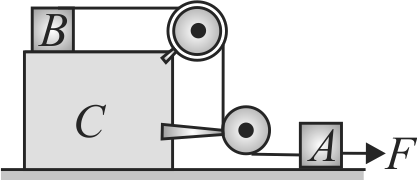
363073
Two masses of 1 \(kg\) and 5 \(kg\) are attached to the ends of a massless string passing over a pulley of negligible weight. The pulley itself is attached to a light spring balance as shown in figure. The masses start moving during this interval; the reading of spring balance will be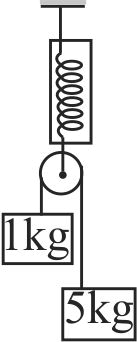
363071
Three blocks \(A, B\) and \(C\) of masses \(10 {~kg}, 10 {~kg}\) and 20 \(kg\) respectively are arranged as shown in figure. All the surfaces are frictionless and strings are inextensible. Pulleys are light. A constant force \(F=20 {~N}\) is applied on block \(A\) as shown. Pulleys and strings are light. Part of the strings connecting both pulleys is vertical and part of the strings connecting pulleys with blocks \(A\) and \(B\) are horizontal. Find the tension in the string.
363073
Two masses of 1 \(kg\) and 5 \(kg\) are attached to the ends of a massless string passing over a pulley of negligible weight. The pulley itself is attached to a light spring balance as shown in figure. The masses start moving during this interval; the reading of spring balance will be
363071
Three blocks \(A, B\) and \(C\) of masses \(10 {~kg}, 10 {~kg}\) and 20 \(kg\) respectively are arranged as shown in figure. All the surfaces are frictionless and strings are inextensible. Pulleys are light. A constant force \(F=20 {~N}\) is applied on block \(A\) as shown. Pulleys and strings are light. Part of the strings connecting both pulleys is vertical and part of the strings connecting pulleys with blocks \(A\) and \(B\) are horizontal. Find the tension in the string.
363073
Two masses of 1 \(kg\) and 5 \(kg\) are attached to the ends of a massless string passing over a pulley of negligible weight. The pulley itself is attached to a light spring balance as shown in figure. The masses start moving during this interval; the reading of spring balance will be
363071
Three blocks \(A, B\) and \(C\) of masses \(10 {~kg}, 10 {~kg}\) and 20 \(kg\) respectively are arranged as shown in figure. All the surfaces are frictionless and strings are inextensible. Pulleys are light. A constant force \(F=20 {~N}\) is applied on block \(A\) as shown. Pulleys and strings are light. Part of the strings connecting both pulleys is vertical and part of the strings connecting pulleys with blocks \(A\) and \(B\) are horizontal. Find the tension in the string.
363073
Two masses of 1 \(kg\) and 5 \(kg\) are attached to the ends of a massless string passing over a pulley of negligible weight. The pulley itself is attached to a light spring balance as shown in figure. The masses start moving during this interval; the reading of spring balance will be
